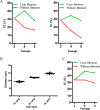Haploid embryonic stem cells can be enriched and maintained by simple filtration
- PMID: 29449377
- PMCID: PMC5892596
- DOI: 10.1074/jbc.RA118.002029
Haploid embryonic stem cells can be enriched and maintained by simple filtration
Abstract
Mammalian haploid embryonic stem cells (haESCs) serve as a powerful tool for genetic analyses at both the cellular and organismal levels. However, spontaneous diploidization of haESCs limits their use in these analyses. Addition of small molecules to the culture medium to control the cell cycle can slow down diploidization, but cell-sorting methods such as FACS are still required to enrich haploid cells for long-term maintenance in vitro Here, acting on our observation that haploid and diploidized cells differ in diameter, we developed a simplified filtration method to enrich haploid cells from cultured haESCs. We found that regular cell filtration with this system reliably maintained the haploidy of mouse haESCs for over 30 passages. Importantly, CRISPR/Cas9-mediated knockout and knockin were successfully achieved in the filtered cells, leading to stable haploid cell lines carrying the desired gene modifications. Of note, by injecting haESCs into metaphase II oocytes, we efficiently obtained live mice with the expected genetic traits, indicating that regular filtration maintained the functional integrity of haESCs. Moreover, this filtration system was also feasible for derivation of mouse haESCs from parthenogenetic haploid blastocysts and for human haESC maintenance. In conclusion, we have identified a reliable, efficient, and easy-to-handle technique for countering diploidization of haploid cells, a major obstacle in haESC applications.
Keywords: CRISPR/Cas; FACS; cell biology; cell sorting; diploidization; embryo; embryonic stem cell; filtration; haploid embryonic stem cells; haploidy.
© 2018 Qu et al.
Conflict of interest statement
The authors declare that they have no conflicts of interest with the contents of this article
Figures




Similar articles
-
Inhibition of Apoptosis Reduces Diploidization of Haploid Mouse Embryonic Stem Cells during Differentiation.Stem Cell Reports. 2020 Jul 14;15(1):185-197. doi: 10.1016/j.stemcr.2020.05.004. Epub 2020 Jun 4. Stem Cell Reports. 2020. PMID: 32502463 Free PMC article.
-
Generation and application of mammalian haploid embryonic stem cells.J Intern Med. 2016 Sep;280(3):236-45. doi: 10.1111/joim.12503. Epub 2016 May 3. J Intern Med. 2016. PMID: 27138065 Review.
-
Generation of haploid embryonic stem cells from Macaca fascicularis monkey parthenotes.Cell Res. 2013 Oct;23(10):1187-200. doi: 10.1038/cr.2013.93. Epub 2013 Jul 16. Cell Res. 2013. PMID: 23856644 Free PMC article.
-
A Genetic Screen Identifies Etl4-Deficiency Capable of Stabilizing the Haploidy in Embryonic Stem Cells.Stem Cell Reports. 2021 Jan 12;16(1):29-38. doi: 10.1016/j.stemcr.2020.11.016. Stem Cell Reports. 2021. PMID: 33440180 Free PMC article.
-
'Artificial spermatid'-mediated genome editing†.Biol Reprod. 2019 Sep 1;101(3):538-548. doi: 10.1093/biolre/ioz087. Biol Reprod. 2019. PMID: 31077288 Review.
Cited by
-
Development and application of haploid embryonic stem cells.Stem Cell Res Ther. 2024 Apr 23;15(1):116. doi: 10.1186/s13287-024-03727-y. Stem Cell Res Ther. 2024. PMID: 38654389 Free PMC article. Review.
-
Mammalian haploid stem cells: establishment, engineering and applications.Cell Mol Life Sci. 2019 Jun;76(12):2349-2367. doi: 10.1007/s00018-019-03069-6. Epub 2019 Mar 19. Cell Mol Life Sci. 2019. PMID: 30888429 Free PMC article. Review.
-
The milestone of genetic screening: Mammalian haploid cells.Comput Struct Biotechnol J. 2020 Sep 12;18:2471-2479. doi: 10.1016/j.csbj.2020.09.006. eCollection 2020. Comput Struct Biotechnol J. 2020. PMID: 33005309 Free PMC article. Review.
-
Chromosome territory reorganization through artificial chromosome fusion is compatible with cell fate determination and mouse development.Cell Discov. 2023 Jan 24;9(1):11. doi: 10.1038/s41421-022-00511-1. Cell Discov. 2023. PMID: 36693846 Free PMC article.
-
Inhibition of Apoptosis Reduces Diploidization of Haploid Mouse Embryonic Stem Cells during Differentiation.Stem Cell Reports. 2020 Jul 14;15(1):185-197. doi: 10.1016/j.stemcr.2020.05.004. Epub 2020 Jun 4. Stem Cell Reports. 2020. PMID: 32502463 Free PMC article.
References
Publication types
MeSH terms
LinkOut - more resources
Full Text Sources
Other Literature Sources
Research Materials

